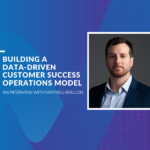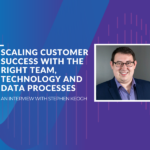The Age Of The Data-Driven Economy
The data-first growth economy is the new (and only) way of doing business. In an Econsultancy survey, 65% of respondents said that improving data analysis capabilities is the most important factor in delivering a great future customer experience (2018). Cutting-edge Customer Intelligence and impactful customer insights are powerful competitive advantages in the new subscription economy, and if you’re not making the most of your customer data, your NDR could take a hit.
With so much data available in enterprise organizations, a strong data collection process is more important than ever. In order to meet the demands of a competitive marketplace and today’s customers, you must streamline all of your data and create a holistic view of the customer in order to become truly customer-centric. Customer Intelligence allows you to do just that. With the right data practices in place, you can understand the right messaging to send to your customers at the right time, tailor value outcomes to each customer and maximize value delivery across the customer journey.
In this article, we outline the evolution of Customer Intelligence and our experts share 5 essential steps to help you unlock the power of revenue-driving Customer Intelligence.
The Evolution Of Data
The role and importance of data have drastically evolved since the time of on-prem and license-based models. Back in the day, data provided little visibility into customers and their health, it was mostly reactive and gut-driven with a lot of guesswork and provided little opportunities for risk identification. Fast-forward to the modern subscription economy, companies are now focused on leveraging data holistically across the entire organization, allowing them to:
- Have a complete 360 degree view of their customers
- Implement a proactive means of engaging with customers with the ability to identify risks for retention and signals for growth
- Build a prescriptive approach to their customer lifecycle with tailored recommendations for each customers’ needs and goals
- Collaborate with cross-functional teams across the entire customer journey
The importance of creating a robust data model cannot be understated. Customer Intelligence gives you the power to accurately tell your customers’ story, deliver an outstanding customer experience and stay differentiated in the marketplace, ultimately creating a powerhouse customer-centric organization.
5 Steps to Unlocking Revenue-Driving Customer Intelligence
1. Centralize Data From Across Your Organization
The first step to creating an effective data model is consolidating all the customer data from across your various functions. Your entire business ecosystem is rich with valuable customer data, both qualitative and quantitative, that can help you strengthen your customer experience. Collaborate with departments like Sales and Product to extract all the data they’re capturing on customer sentiment and product usage and combine it with data from Customer Success, Professional Services and Support to create a robust view of your customers.
The next step is to clean up this data and create a unified view across all of your departments. When using disparate systems and differentiated data practices, there is often a disconnect between the data of a single customer across each function. To remedy this, ensure that names and numbers are inputted correctly and that each customer has the same unique signifier across all departments. Once you have a uniform view of your data across your organization, you can begin to derive meaningful customer insights that accurately capture all of the touchpoints in the customer’s journey.
2. Analyze Customer Insights To Drive Value
With a holistic view of your customers across the customer journey, you can effectively analyze your data for meaningful customer insights and determine which factors are driving value. Assess what your customer data is telling you about what is going well, what is challenging and where there are opportunities for advancement and improvements in your people, processes and product. Compare your data against historical metrics to see how you’re tracking as an organization and against industry standards. For example, if you collect CSAT for onboarding or certain product adoption metrics, it can be helpful to benchmark that against industry standards to give you a sense of what others in the industry are doing well and that you can leverage within your own organization.
3. Take Action On Key Learnings
Gathering and analyzing all of this customer data is an exceptional step forward, but don’t stop there. Your organization needs a proper process for generating strategic actions that help you continuously improve and enhance the customer experience over time. Once you have the data and customer insights necessary to understand your customers, you need to translate this into specific actions that everyone in your organization can take. This step is crucial to developing actionable insights that can focus your value-driving activities where they are needed most. This can also help you scale your digital engagement model across different customer segments.
4. Share Key Insights With Your Entire Organization
Don’t let the barriers that may exist between your organizations extend to all of the valuable and actionable customer insights you have generated. Communicate your findings with each department so that they can improve their own processes and optimize their customer interactions. For example, if you do an NPS survey on a regular basis, do you share the results with each function? Do you share customer comments with each department? Take this a step further and mandate that after every NPS survey, every function has to identify one priority from the data that’s been gathered and one strategic action that they’re going to take. Then, make sure you communicate these changes back to your customers – this way, they’ll know that their feedback actually made an impact and they’ll be incentivized to continue doing so.
5. Repeat The Process For New Data And Accounts
Customer Intelligence isn’t just pulling data together, deriving customer insights and taking action one time. It’s an ongoing process of continuous improvement. Your customers and their needs are constantly evolving and so is the market and your data. To keep on top of all of these changes, and base your actions on the most up-to-date and accurate information, you need to evaluate and iterate on this process often. Ultimately, Customer Intelligence and data has to be built into your organizational culture and mindset as it drives your strategy, people and processes.
For a deep dive into what advanced Customer Intelligence-driven organizations look like and how you can get there, watch our latest webinar with Mary Poppen, Chief Strategy and Customer Officer at Involve.ai.
Join The Customer Intelligence Movement
Market-leading tech companies are the ones who are making informed business decisions from a strong Customer Intelligence model. In an age when customers know exactly what they want and expect the best, cutting-edge Customer Intelligence can help you identify their needs and create strategies that deliver exceptional customer experiences, ultimately driving unparalleled customer retention and expansion in your business.
Using data to create meaningful outcomes requires an unwavering focus on your most important asset: your customers. Follow these 5 critical steps to scaling a powerful Voice of Customer program that provides unprecedented insights to drive deeper customer relationships and accelerate the achievement of your business goals.





